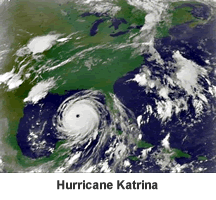
The fifth anniversary of Hurricane Katrina (Aug. 29) has caused many Americans, and the news media in particular, to look back on that tragic event and reflect on its meaning.
Joannes Westerink, a professor of civil engineering and geological sciences at the University of Notre Dame, has especially keen insights into Katrina and its significance. As the hurricane unfolded, he was providing forecasts of its incoming storm surge, and in the storm’s aftermath, he played a leading role in the effort to understand the causes of the catastrophe and the development of steps needed to prevent its reoccurrence.

In 1991, Westerink and his MIT classmate Rick Luettich, now a University of North Carolina professor, developed ADCIRC: the Advanced Circulation Model. ADCIRC has since become the authoritative computer model for storm surge used by the U.S. Army Corps of Engineers, the Federal Emergency Management Agency (FEMA), and the state of Louisiana to determine water levels due to hurricane surge and to design levee heights and alignments.
ADCIRC employs computer science, coastal oceanography, mathematics and engineering to forecast tides, riverine flows, wind and wave-driven currents, as well as incoming storm surge. Storm surge is the wall of water pushed onto land as a hurricane comes ashore. The model is increasingly more accurate as geographic detail, resolution and the underlying physics and computational engines are improved. Recent refinements have increased its accuracy to within half a meter 90 percent of the time in hindcasting high water for a hurricane.
As he reflects back on Katrina and its aftermath, Westerink feels that the $15-billion dollar effort that created 350 miles of flood protection in the wake of the hurricane represents real progress.
“This was an enormous and very successful effort to build a flood protection system that will does a good job of trying to do what was supposed to have been done in the wake of Hurricane Betty in 1965.” he said. “Congress finally stepped up to the plate and provided the massive construction funds to provide protection that should be effective for approximately 40 years.”
However, Westerink believes that there are major issues that still need to be addressed. In particular, he feels that a layered system of protection that places greater safeguards on especially vulnerable areas of the Gulf Coast with high population levels needs to be developed.
“It’s not financially feasible to build a 1,000-year protection system for all 350 miles, but we have to envision how to build a system for a city like New Orleans where we need to build citadels that provide much higher levels of protection in densely populated areas, ” he said.
The Notre Dame researcher also feels that all levels of government from the federal level to state of Louisiana and the city of New Orleans need to make use of better city planning to guard against future hurricanes.
Westerink received the U.S. Department of the Army Outstanding Civilian Service Award for his efforts as co-chair of the regional hydrodynamics team of the Interagency Performance Evaluation Task Force (IPET). IPET was a U.S. Army Corps of Engineers-led eight-month, $20-million performance evaluation of the New Orleans and Southeast Louisiana Hurricane Protection system during Hurricane Katrina that was conducted by 150 leading corps engineers, academics, and government and private sector scientists and engineers.
The award citation noted Westerink’s superior level of performance and tireless devotion which positively impacted IPET project success and contributed greatly to the reconstruction efforts of the New Orleans Hurricane Protection System.
Westerink and his research partners also received funding from the Department of Homeland Security and the National Science Foundation to apply the ADCIRC program to the Horizon oil spill off the Louisiana coast so they could provide “nowcasts” and forecasts of the oil spill movement to the inner-shelf, near shore and inner-shore areas of coastal Louisiana, Mississippi and Texas.
More information on Westerink’s research is available here.
Contact: Joannes Westerink, 574-631-6475, jjw@nd.edu